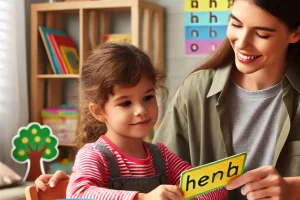Phonological vs. Phonemic Awareness: Understanding the Difference

Phonological awareness and phonemic awareness are often used interchangeably, but they refer to different concepts in early literacy development. Both skills are critical for reading success, but they represent different levels of sound awareness. In this article, we’ll explore phonological vs. phonemic awareness, explain their differences, and provide tips for teaching each skill effectively.
Discover the Children Learning Reading program, a structured way to enhance both phonological and phonemic awareness for young learners.
What Is Phonological Awareness?
Phonological awareness is a broad skill that involves recognizing and working with sounds in spoken language. It includes identifying and manipulating larger units of sound, such as syllables, rhymes, and words.
Examples of Phonological Awareness Skills:
- Recognizing Rhymes: Identifying that “cat” and “hat” rhyme.
- Clapping Syllables: Breaking the word “banana” into syllables: ba-na-na.
- Identifying Onsets and Rimes: Recognizing the “b” sound in “bat” as the onset and “-at” as the rime.
What Is Phonemic Awareness?
Phonemic awareness is a subset of phonological awareness. It focuses specifically on identifying and manipulating the smallest units of sound, or phonemes, in words.
Examples of Phonemic Awareness Skills:
- Blending Phonemes: Combining “d-o-g” to form the word “dog.”
- Segmenting Phonemes: Breaking “cat” into its individual sounds: “c-a-t.”
- Manipulating Phonemes: Changing the “m” in “mat” to “h” to form “hat.”
Key Differences Between Phonological and Phonemic Awareness
| Aspect | Phonological Awareness | Phonemic Awareness |
|---|---|---|
| Scope | Broad (includes words, syllables, rhymes, phonemes) | Narrow (focuses only on phonemes) |
| Examples | Recognizing rhymes, clapping syllables | Blending, segmenting, and manipulating phonemes |
| Focus | Larger sound units (e.g., syllables) | Smallest sound units (individual phonemes) |
| Teaching Stage | First step in sound awareness | Builds on phonological awareness |
Why Are Both Important?
Both phonological and phonemic awareness are critical for developing strong reading and writing skills.
- Phonological Awareness: Provides a general understanding of sound patterns in language, which is the foundation for literacy.
- Phonemic Awareness: Prepares children to decode words and understand the relationship between sounds and letters.
Together, these skills enable children to read fluently, spell accurately, and comprehend text effectively.
How to Teach Phonological Awareness
- Use Rhyming Games
- Read books with rhymes like “The Cat in the Hat.”
- Play rhyming games where your child identifies or creates rhyming words.
- Practice Syllable Clapping
- Break words into syllables by clapping (e.g., “elephant” becomes “el-e-phant”).
- Sort Words by Sounds
- Group words based on their beginning, middle, or ending sounds.
How to Teach Phonemic Awareness
- Blending and Segmenting Sounds
- Say the sounds of a word separately (“b-a-t”) and ask your child to blend them into the full word (“bat”).
- Break words into individual sounds (e.g., “dog” becomes “d-o-g”).
- Manipulate Sounds
- Ask your child to replace sounds in a word to form a new one (e.g., change “bat” to “cat”).
- Use Visual Aids
- Use letter cards or flashcards to help your child connect sounds with letters during activities.
Everyday Opportunities to Build Awareness
- During Reading Time: Highlight rhymes, syllables, or sounds in books.
- In Daily Conversations: Play sound games while cooking or shopping.
- Through Songs and Poems: Use songs and nursery rhymes to practice sound patterns.
Why Choose a Program Like Children Learning Reading?
While teaching these skills independently is possible, a structured program like Children Learning Reading simplifies the process. It provides:
- Step-by-step lessons for both phonological and phonemic awareness.
- Engaging activities that develop key literacy skills.
- Proven methods to transition from sound awareness to fluent reading.
Final Thoughts: Phonological vs. Phonemic Awareness
Understanding the difference between phonological and phonemic awareness is essential for teaching literacy effectively. Phonological awareness focuses on larger sound units, while phonemic awareness hones in on individual phonemes. Together, these skills build a strong foundation for reading and writing success.
Ready to give your child the tools they need to thrive? Explore the Children Learning Reading program for proven strategies to develop both phonological and phonemic awareness. Start today and watch your child’s literacy skills flourish!








